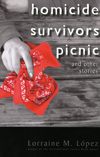Homicide Survivors Picnic
It should come as no surprise that the ten stories in Lorraine Lopez’s collection Homicide Survivors Picnic make an impact, bringing the reader face-to-face with situations that are realistic and gritty but never hopeless or pitiful. Lopez, the winner of the International Latino Book Award for short stories, among other accolades, handles intricate characters and complex emotions deftly, all while spinning out plots that are captivating and believable.
It should come as no surprise that the ten stories in Lorraine Lopez’s collection Homicide Survivors Picnic make an impact, bringing the reader face-to-face with situations that are realistic and gritty but never hopeless or pitiful. Lopez, the winner of the International Latino Book Award for short stories, among other accolades, handles intricate characters and complex emotions deftly, all while spinning out plots that are captivating and believable.
Lopez’s stories are traditional in form, anchored in semi-urban, lower-middle class reality. The people in her narratives drive cars like a “dusty Honda hatchback,” which an ex-wife secretly calls “the filth-mobile.” They live in modest houses, stay in cheap hotels, or rent apartments where the sinks are “stained with rust streaks, the countertops lucent with grease.” Such details in the stories are more than setting; they echo the characters themselves, worn-out, neglected, and a bit on the rough side. Even the jobs these folks have, a grant writer for Catholic Social Services, a mediation counselor, a social worker for substance abuse, speak for the rougher sides, the needs, within society. Lopez embraces characters who are teetering on the edge.
The collection is bookended by two linked stories, “The Flood” and “The Landscape,” that feature Lydia, a junior college professor who is taking care of Roxanne, her sister’s child, while her sister serves a jail term for drug use. Like many of the characters in these stories, Lydia isn’t used to children, isn’t sure what it means to take care of them; she takes Roxanne to museums and muses that “the past must seem a distant planet to her . . . these strangely garbed figures, with their out-dated contraptions and tools, as alien and incomprehensible as extraterrestrials.” Lydia, like the child she wonders about, is displaced, uncomfortable, a feature which, again, is echoed by the setting. As I finished the collection, reaching the last pages of “The Landscape,” it was incredibly satisfying to return to these characters with which the book began; Lopez provides a happy ending, a sense of growth and promise, without being trite.
Lydia and Roxanne are just one example of the most prevalent theme in these pieces: adults who are forced into playing a parental role. In other stories, grandparents must take custody of grandchildren as their own kids flounder with legal troubles or mental illness. Lovers walk in to relationships where someone else’s children dominate the household. Lopez has a knack for capturing children’s behavior, from the whiny tones of bored five-year-olds to the petulance of teenagers, as when one new boyfriend of a divorcee observes her two daughters who “have the habit of opening the refrigerator to scrutinize the contents when they return to the house, as though they expect transubstantiation to have occurred in its frosty recesses during their absence.” Small details like this make even the minor characters memorable.
Although Lopez explores common themes such as love, belonging, and identity, her stories move in unexpected ways. In part, this is due to her engagement with tough issues, the grittiness of real lives that don’t go smoothly. But it is also because Lopez creates characters who have depth and a real sense of interior life. With quick brushstrokes, she paints in new dimensions, like the teacher who “relegated the best of what she had to say to the parenthesis, the suppressed feeling, the unspoken thought.” Or the young man at the heart of the title story, a boy to whom others are drawn, who finds himself constantly being confessed to and wonders “what would happen if people weren’t allowed to speak unless they said what they meant. He imagined a delicious silence unfurling like a beach blanket on sun-warmed sand.” These are characters who have their own deep-seated desires, who don’t behave predictably; consequently, the stories, even those with familiar premises, explore new and unanticipated avenues.
As with many short story collections, Homicide Survivors Picnic suffers from a bit of evenness. “The Imam of Auburn,” for instance, simply feels out of place, with characters, content, and pacing that don’t match the other pieces in the collection; it is the only story that doesn’t deal with children in any capacity and the only one in which the main character is the individual suffering with mental illness. In all the other stories, the main character is either the caregiver, the responsible one, or the child who is displaced by the mental illness or substance abuse. Instead of providing a respite, “The Imam of Auburn” is jarring, breaking the consistent mood and the development of the cross-collection themes.
Lopez has written stories that are eminently readable, with plot and characters that are not only believable but familiar. She doesn’t shy away from issues of race and class, and while all of her stories carry in them the sense of hope, her writing is never maudlin. There is much to enjoy about this collection.





